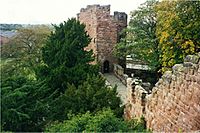Water Tower, Chester facts for kids
Quick facts for kids Water Tower |
|
|---|---|

Spur wall leading to the Water Tower
|
|
| Location | Chester, Cheshire, England |
| OS grid reference | SJ 399 665 |
| Built | 1325 |
| Architect | John Helpston |
|
Listed Building – Grade I
|
|
| Official name: Spur wall and Water Tower | |
| Designated | 28 July 1955 |
| Reference no. | 1376129 |
| Lua error in Module:Location_map at line 420: attempt to index field 'wikibase' (a nil value). | |
The Water Tower is an old tower from the 1300s in Chester, England. It is connected to Bonewaldesthorne's Tower on the city walls by a special connecting wall. This tower and its wall are very important. They are listed as a Grade I building, which means they are of great historical interest. The tower was first called the New Tower, but later people started calling it the Water Tower.
Contents
History of the Water Tower
When Was the Water Tower Built?
The Water Tower was built between 1322 and 1325. At that time, it stood right in the River Dee. It was designed by an architect named John Helpston. He also designed castles for King Edward II in North Wales.
Why Was the Water Tower Built?
The main reason for building the tower was to protect Chester's port. It also helped keep an eye on ships. This made sure that ships paid their customs fees. The tower and its connecting wall cost about £100 to build. This was a lot of money back then.
How Did the Tower Change Over Time?
By the late 1500s, the river had filled up with mud. This meant the tower was no longer in the water. In 1639, the city fixed up the tower. During the next ten years, openings in the wall were made into places for cannons. The tower was damaged during the Civil War.
From 1671, the tower was rented out as a storage building. But by 1728, people said it was "useless and neglected."
The Tower as a Museum
In 1835, a group called the Chester Mechanics' Institution started. They wanted to open a museum. So, the city council let them use the Water Tower and Bonewaldesthorne's Tower. The museum opened in 1838.
The Institution closed in 1876. The city council then took over the museum items. Even though the tower was not perfect for a museum, there was no other place to show everything. The tower closed for a short time in 1901–02 while the city walls were rebuilt. It reopened in 1903 and had many visitors.
The towers closed to the public in 1916. In the 1920s, they were used for other things, not as a museum. In 1954, the Grosvenor Museum bought them. They reopened the towers to the public in 1962.
Today, the tower is about 200 meters (200 yards) away from the river. It is one of the best-preserved medieval towers in Chester. Since 2016, the Water Tower and Bonewaldesthorne's Tower have been home to a museum about the history of medicine called 'Sick to Death'.
What Does the Water Tower Look Like?
The tower and its connecting wall are made of sandstone rocks. The tower is about 23 meters (75 feet) tall. The wall is about 30 meters (97 feet) long. It is just over 3 meters (11 feet) wide and about 7 meters (24 feet) high.
How to Reach the Tower
An archway in the city walls leads to 44 stone steps. These steps go down to the tower. The wall has a special top edge with gaps, called crenellations. This might be the only old medieval crenellation left on the city walls.
Inside the Tower
The tower is round at the bottom. Above that, it has a square part with two levels. Each level has an eight-sided room. A pointed archway connects the wall to the lower room. There was also a small latrine (toilet) in the corner between the tower and the wall.
Five stone steps lead down from the archway through the thick wall (about 3.7 meters or 12 feet thick) to the lower room. This room used to have openings for shooting, called embrasures. But these have been filled in and can only be seen from outside.
A circular staircase with 23 steps goes up to the top room. This room has four embrasures in its walls. Above this room is a raised platform for fighting. It looks over the tower's entrance. The very top of the tower also has crenellations.

